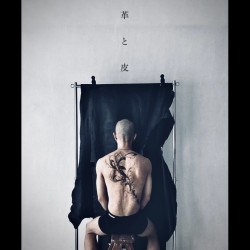
April 13, 2006
Man vs Mountain
For Tokyo resident Blair Falahey, Everest is just one more obstacle to overcome
By Metropolis
Originally published on metropolis.co.jp on April 2006

Photos courtesy of Blair Falahey
Blair Falahey puts his hands on the table in front of me. They look normal, until he points out that three fingers are too short, the result of a fateful ascent of Mt. Cho Oyu in the Himalayas in 2003.
At the hospital, “they wore down the bones and pulled the skin over the ends until they came together again,” recalls the 35-year-old Australian, who earlier this year chucked in his job at a relocation company in Tokyo and said goodbye to his buddies in Roppongi. Now he’s back in the Himalayas planning an ascent of Mt. Everest from Tibet without oxygen. Only about 40 climbers have ever reached the summit of Everest without oxygen, of which 10 never made it back alive, he says.
Taking the Tibetan route means Falahey will avoid the Khumbu Icefall, one of the most treacherous parts of the approach from Nepal, where he witnessed a climbing companion fall to his death last year. Instead, he will follow a similar route to that taken in 1924 by British explorers George Mallory and Andrew Irvine. The pair was seen starting out on the final approach to the summit but died before anyone could find out whether they actually got there, 29 years before Sir Edmund Hillary and Tenzing Norgay.
Falahey’s intention not to use oxygen also echoes Mallory, who famously declared that doing so would be unsportsmanlike—“un-English.” In the end, Mallory used it anyway and concluded that it would otherwise be impossible to combat altitude sickness and reach the top.
At high altitudes the human body cannot get the oxygen it needs to function properly. Mild altitude sickness causes headaches and nausea. In extreme cases it can make climbers confused, hallucinatory or even psychotic. Hillary and Norgay used oxygen (the first expedition without it wasn’t until 1978) and, like all climbers, whatever their intentions, Falahey will carry a supply for emergencies—17 bottles, in fact, enough for two summit attempts, he says.
Everest is 8,884m high and growing by 3-5mm a year. Above 7,500m, nothing can survive naturally. Falahey says the main challenge on the Tibetan side will be spending a night (without oxygen, he hopes) at the final “summit camp,” which is at 7,775m, practically within the so-called “death zone” of 8,000m and higher.
On the steep Nepalese side, it doesn’t take long for a sick climber to descend to a lower altitude, or, in an emergency, to arrange a helicopter rescue. In Tibet, the relatively gentle gradient means it can take days of walking to reach a safe altitude, and the Chinese authorities are not equipped for rescues.
Falahey says he knows what altitude sickness feels like from when he first started climbing in South America in the mid-’90s. “I was just a kid, and I got the shit kicked out of me.” The son of a local surf hero from Melbourne, Australia, he spent his younger years globetrotting in search of the perfect wave and even toyed with the idea of becoming a professional surfer. It was while he was on the beach in Ecuador that he first looked inland and discovered mountain climbing on Mt. Cotopaxi. He later went to New Zealand to train with Bill Atkinson, one of the world’s most respected instructors, who remembers his student as “ambitious, but cautious. He asked all the right questions.”
These days Everest is not technically very hard, compared to when Hillary and Norgay did it,” says Gota Muira, who climbed Everest from Nepal with his then 70-year-old father, Yuichiro, in 2003. If Falahey reaches the summit on a clear day, he can expect to be joined by perhaps 50 others, Miura says. Over the last five decades, more than 2,200 people have reached the top (more than 186 have died), leaving ropes and climbing positions along the way, especially on the Tibetan side, where there are even permanent ladders in some especially tricky places.

Strong Sherpas are indispensable
The most important aid is a strong, reliable Sherpa—or preferably several strong, reliable Sherpas. Coming from among the highest inhabitable land in the world, Sherpas are naturally acclimatized. They do not suffer from altitude sickness like most climbers, so they can carry more, climb or descend faster, and remain clear-headed.
Falahey suffered a setback in March when his lead Sherpa, a 27-year-old personal friend named Mingma, had to cancel because of a stomach ulcer.
“I was devastated,” says Falahey, in a subsequent email interview from Katmandu. “I was so looking forward to climbing with my good friend. My chances of summiting decreased by 20 percent—that’s how awesome he was.” His second choice was Mingma’s younger brother, Tashi, the youngest person ever to climb Everest without oxygen, but Tashi was committed to an expedition from South Korea.
After searching for several weeks, Falahey says he now has the right Sherpas to accompany him: Karma, 21, has already summited twice; Pasang Nuru, 31, has made three attempts but never summited, twice turning back to rescue clients.
“Sometimes multiple summiters are only going back for the money,” says Falahey. “Their heart is not in it. If I summit with Pasang this year… hopefully we will both enjoy the elation of getting there for the first time together,” rather like Hillary and Norgay.
Those pioneers wouldn’t have the first idea what to do with much of the advanced equipment Falahey will take with him: tents, stoves and sleeping bags all especially designed for high altitudes; non-freeze goggles; lightweight boots with strap-on crampons; $1,000 climbing suits; and gadgets like “pulsoximeters,” which measure oxygen levels in the blood.
But all the flashy equipment in the world sometimes isn’t enough. On January 28, one of the world’s most experienced mountaineers, Jean Christophe Lafaille, disappeared during a solo climb of Mt. Makalu in eastern Nepal. The 39-year-old Frenchman was trying to become the first person to scale Makalu alone in winter.
“Everybody thought Jean Christophe was superhuman,” says Falahey. “Like when he got hit by an avalanche on Annapurna and got himself off the mountain with a broken elbow, ten meters of rope and a broken ski pole.”

Falahey's frostbitten hands after Cho Oyu
Falahey prefers to look to another legend in France, albeit an American: cyclist Lance Armstrong, who overcame cancer before winning the Tour de France a record seven consecutive times. He has a quote from Armstrong’s book, It’s Not About the Bike: My Journey Back to Life, pinned to the inside of his tent: “Pain is temporary; giving up is forever.”
Ten years ago, Falahey nearly lost his arm after he was attacked with a machete by thieves on a beach in Lombok, Indonesia. Doctors told him he would never climb again. Three years ago, when he lost the ends of his fingers, different doctors told him the same thing. He has proved them all wrong.
Even so, he admits he has made mistakes. “I was horribly inexperi-enced,” he says looking back at Cho Oyu. It was his first attempt to climb above 8,000m, and he went alone, joining a group of climbers with no Sherpas and no support. In terrible weather they battled their way up the mountain for weeks until, exhausted, they reached high camp and prepared for the summit. But the German he was with showed signs of severe altitude sickness, so he helped the man down, taking off his gloves to do so. Removing his gloves was the first of several costly mistakes, and Falahey was soon forced to abandon the climb just a few hundred meters from the summit. He lost his fingers; the German and another Australian from the group both died of altitude sickness.
As a result, Falahey’s fingers are extra susceptible to the cold, so it may sound foolhardy that he is now attempting Everest. Even considering the deaths of his friends, he remains sanguine: “In this environment you kind of expect things to happen; you are mentally prepared to deal with it… If you lost a friend because he got hit by a car I think it would affect you more.”

Falahey with his Sherpa on Mt. Lhotse
Isn’t he just a crazy, gung-ho Aussie? “In part, that’s true,” he replies, before countering with another quote, this time from the Italian climber Walter Bonatti: “It is to conquer fear that one becomes a climber. The climber experiences life to its extreme limits. A climber is not a crazy man. He is not trying to get himself killed. He knows what life is worth. He is in love with living.”
Fellow risk-takers are perhaps more understanding than the rest of us. “Mountain climbing is always a challenge. The more support you have, the less independence there is and the smaller the challenge,” says Miura, who is planning another ascent of Everest, this time from Tibet, with his father in 2008. That will be the year of the Beijing Olympics, by which time the elder Miura will be 75.
Miura’s final advice is simple: know your limits. Only a third of climbers attempting Everest actually make the summit, but “as long as you live, you always have another chance.”
Falahey’s incentives to make sure he makes it down alive are simple: his family in Australia (he flew his father to Nepal in March so they could train together) and his friends in Tokyo. “The climbers that come back alive are the ones that have people at home waiting for them,” he says. “Everest is not worth giving my life for. This mountain’s not going anywhere but up.”
All going well, Blair Falahey will tell Metropolis about his climb once he returns to base camp in late May, or see http://blair8850.blogspot.com to track his progress. Falahey expressed his appreciation for the support of The North Face, Black Diamond, Outdoor Research, Brunton Solar and Jensen Communications, and his friends at Geronimo’s and Mugambo’s. You can offer him moral support via email to blair8488@hotmail.com or financial support via Paypal to the same address.







